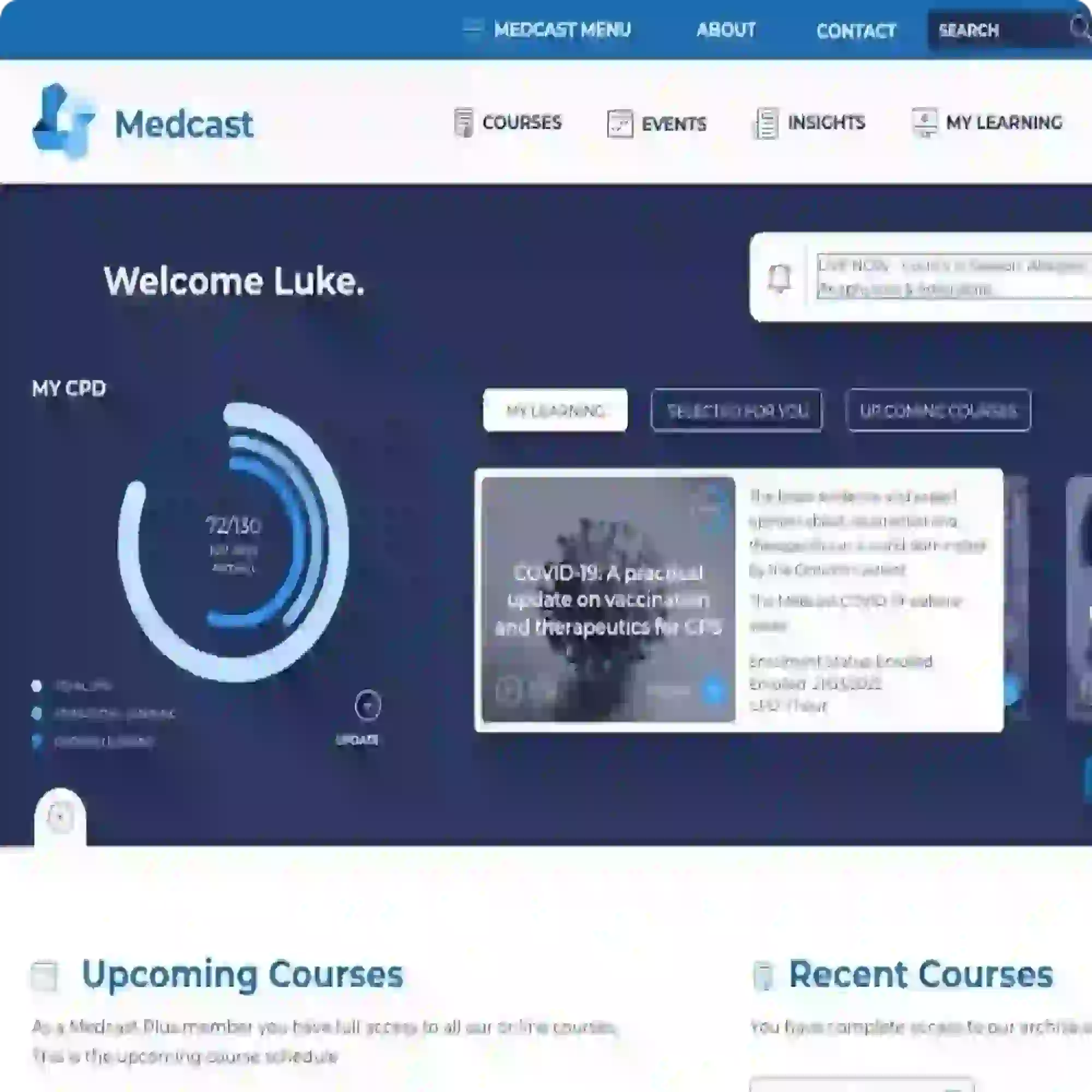Chronic lower back pain - clinical fact sheet and MCQ
Overview
Chronic lower back pain (CLBP) is a leading cause of disability worldwide. Nonspecific or primary CLBP is defined as persistent or recurrent pain persisting beyond three months without a clear underlying pathology such as an inflammatory autoimmune condition or structural lesion.
It significantly affects quality of life, function, and mental wellbeing but with support, self-management and other treatment symptoms can be managed.
Diagnosis of chronic lower back pain
CLBP is primarily a clinical diagnosis based on history and clinical examination:
-
evaluate pain characteristics (onset, duration, aggravating/alleviating factors, radiation, and functional impact)
-
assess for psychological distress, PTSD, and social determinants impacting pain perception
-
perform a physical examination, including gait assessment, neurological testing (reflexes, sensation, strength), and provocative tests (eg, straight leg raise for radiculopathy)
-
Note: radiating pain down the leg may also be associated with nonspecific CLBP
-
Differential diagnoses for chronic lower back pain:
-
mechanical CLBP is the most common (eg, muscle strain, facet joint arthritis, degenerative disc disease)
-
radiculopathy (eg, sciatica, lumbar disc herniation, foraminal stenosis)
-
serious pathologies and red flags when assessing CLBP include:
-
spinal osteomyelitis or epidural abscess (fever, IV drug use, immunosuppression)
-
malignancy (unexplained weight loss, history of cancer, pain at multiple sites, pain at rest)
-
vertebral fracture (trauma history, osteoporosis, chronic steroid use)
-
cauda equina syndrome (bilateral or alternating radiculopathy, saddle anaesthesia, bowel/bladder dysfunction, severe motor weakness - refer urgently)
-
myelopathy (gait disturbance, reduced balance, clonus, sensory loss)
-
axial spondyloarthritis (young age (<40 years), prolonged morning stiffness, alternating buttock pain, improvement with activity, and failure to improve with rest)
-
Imaging:
-
not required for most cases unless red flags are present or symptoms persist despite conservative management for >6 weeks
-
MRI is preferred if neurological deficits or suspected malignancy/infection due to superior sensitivity and safety
In October 2024, the Department of Veterans’ Affairs (DVA) began a 6 month trial allowing radiologists to claim MRI scans for eligible clients referred by a GP without needing to seek prior approval from DVA. This reduces administrative burdens and wait times.
Management of chronic lower back pain
The World Health Organisation recommends a non-surgical, multimodal approach integrating education, physical, psychological, and pharmacological interventions. This integrated biopsychosocial approach is considered to be the most effective.
For all interventions, emphasise functional improvement over pain elimination.
1. Non-pharmacological interventions (first-line)
-
Education and self-management:
-
provide structured education about the pain experience, as well as actions that can be taken to improve such as benefits of physical activity, ergonomic advice, self-care strategies, and engagement in social and work activities
-
not all patients may appreciate or benefit from education for management of their pain and may have preference for alternative interventions
-
there are many useful resources to support patient education around pain such as those on Open Arms and MyBackPain, apps like Mindspot and Curable, and videos such as Tame the Beast
-
-
Physical therapy and exercise:
-
encourage regular, individualised exercise programs
-
no exercise modality is superior to another
-
comprehensive guidelines on physical activity and sedentary behaviour can be found here
-
evidence for spinal manipulation or massage is unclear. It may be beneficial as an adjunct therapy but any contraindications (particularly to manipulation) must be first identified, such as osteoporosis
-
-
Psychological interventions:
-
cognitive behavioural therapy (CBT) helps manage pain-related distress and mental illness, and improves coping strategies
-
mindfulness-based stress reduction may be considered but there is insufficient evidence to recommend for or against
-
if significant PTSD, depression, or opioid dependence, refer for psychiatry/psychology assessment
-
-
Assistive devices:
-
mobility aids may help selected patients with significant disability
-
lumbar braces/belts are not recommended for routine use
-
DVA can support eligible veterans with CLBP through funding for exercise physiologists, physiotherapists, dieticians, psychologists, other allied health providers and mobility aids as appropriate.
2. Pharmacological management (second-line)
-
Non-steroidal anti-inflammatory drugs (NSAIDs) are first-line for pain relief, used intermittently at the lowest effective dose
-
most NSAIDs are considered equally effective, including ibuprofen, indometacin, diclofenac, piroxicam, naproxen, meloxicam, ketoprofen, etoricoxib, and celecoxib
-
consider prescribing a gastro-protective medication to reduce the risk of gastrointestinal complications
-
there is insufficient evidence to support the efficacy of paracetamol in CLBP, though it may have a role if NSAIDs are unsuitable
-
anticonvulsants, tricyclic antidepressants, selective serotonin and noradrenalin reuptake inhibitors, cannabinoids, and benzodiazepines are not recommended due to limited efficacy and the potential for harm
-
opioids should be avoided in chronic non-cancer pain due to high addiction risk, and minimal evidence for long-term benefit
-
corticosteroid injections and local anaesthetic blocks have not demonstrated significant treatment benefit for nonspecific lower back pain
-
medical management of neuropathic pain requires considering different options
3. Complementary and alternative therapies
-
Acupuncture/needling may provide short-term relief
-
caution patients on anticoagulants due to risk of bleeding at needling sites
-
transcutaneous electrical nerve stimulation (TENS), traction, and therapeutic ultrasound are not recommended due to limited evidence
If the pain is refractory to multimodal treatment after 6 to 12 weeks, consider referral for specialist pain management.
Prognosis
Certain factors increase the likelihood of a poor prognosis for primary CLBP:
-
more severe pain at presentation
-
higher level of disability at presentation
-
concurrent leg pain
-
older age
-
mental illness, including anxiety and depression
-
poor overall health
A poor understanding of the nature of primary CLBP may also increase the risk of an unfavourable prognosis due to unhelpful or harmful adaptive behaviours. Patients should be educated that:
-
pain during physical activity doesn’t necessarily equate to further damage and injury
-
active participation in management strategies are more effective than passive therapies (such as massage or acupuncture) alone
-
engaging with their usual physical activities as much as possible, as well as working, can aid recovery
-
prolonged bed rest and a sedentary lifestyle is unhelpful and may result in protracted pain, muscle wasting, and physical deconditioning
For further information about the management of chronic pain in veterans, watch the webinar: An approach to chronic pain in veterans
References
-
WHO guideline for non-surgical management of chronic primary low back pain in adults in primary and community care settings. Geneva: World Health Organisation; 2023. Licence: CC BY-NC-SA 3.0 IGO. (last accessed February 2025).
-
Australian Commission on Safety and Quality in Health Care. Low Back Pain Clinical Care Standard (2022). 2022. (last accessed February 2025).
-
Therapeutic Guidelines. Nonspecific low back pain. 2024. (last accessed February 2025).
Claim your CPD
After reading the clinical summary above and reviewing the references, complete the quiz to gain 30 minutes of EA CPD and 30 minutes of RP CPD.
You can either self-report CPD to your CPD home, or Medcast will track your learning via your personal CPD Tracker and you can download and report these points once a year. See our CPD Tracker FAQ.
Quiz
Complete the following five (5) questions, and review the answers to complete this learning activity
|
Endorsed by: VETs HeLP: Veterans Healthcare eLearning PlatformAn initiative funded by the Australian Government through the Department of Veterans’ Affairs. |
The Medcast medical education team is a group of highly experienced, practicing GPs, health professionals and medical writers.
The Coordinated Veterans’ Care (CVC) Program is a DVA initiative that allows GPs to provide structured, proactive care in the community for eligible veterans and war widows. This FastTrack provides a guide to billing the CVC program, and outlines a strategy for its practice-wide integration.
Achilles tendinopathy is a common cause of posterior heel pain and functional impairment. GPs are well-placed to coordinate care for these patients. This FastTrack fact sheet provides a concise summary of diagnosis and non-surgical management, including when to refer. Earn 30mins each RP and EA CPD with the quiz.
Over 3% of GP consultations in Australia involve skin lesions, yet many practices are billing these procedures incorrectly, putting themselves at risk of noncompliance or missing out on legitimate remuneration. This Business skills FastTrack explains the MBS item numbers pertaining to skin lesions for GPs, including eligibility criteria and practical tips.


